




Published 5 July 2007
URL: http://www.kingcorn.org/news/articles.07/Drought-0705.html
Assessing Effects of Drought on Corn Grain Yield?
R.L. (Bob) Nielsen
Agronomy Dept., Purdue Univ.
West Lafayette, IN 47907-2054
Email address:
![]() arts
of Indiana remain abnormally dry as we approach the middle of the growing
season for corn; especially the southeastern areas of the state. Nearly
64% of Indiana was classified as abnormally dry while 13% of the state
was classified as experiencing moderate drought conditions as of 3 July
according to the U.S.
Drought Monitor Web site (Fig. 1). Rains throughout the state during
the past week have actually moderated the drought ratings somewhat compared
to recent weeks; which is also reflected by the slight improvement in
USDA
estimates of Indiana’s corn crop condition as of 1 July (Fig. 2).
arts
of Indiana remain abnormally dry as we approach the middle of the growing
season for corn; especially the southeastern areas of the state. Nearly
64% of Indiana was classified as abnormally dry while 13% of the state
was classified as experiencing moderate drought conditions as of 3 July
according to the U.S.
Drought Monitor Web site (Fig. 1). Rains throughout the state during
the past week have actually moderated the drought ratings somewhat compared
to recent weeks; which is also reflected by the slight improvement in
USDA
estimates of Indiana’s corn crop condition as of 1 July (Fig. 2).
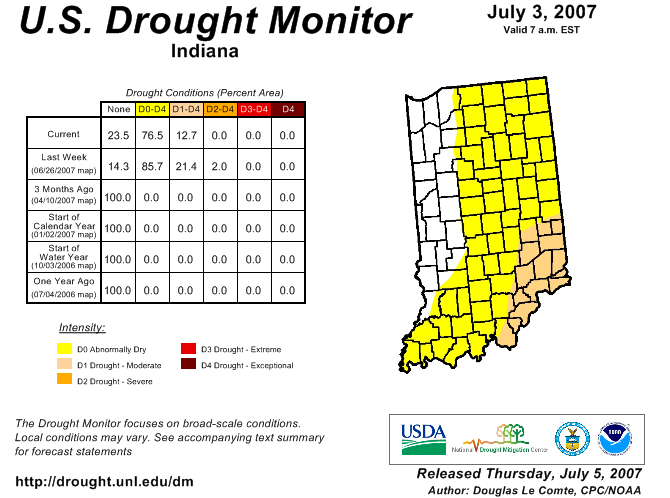
Fig. 1. Estimates of drought conditions throughout Indiana as of 3 July
2007. Source: US Drought Monitor, http://drought.unl.edu/dm
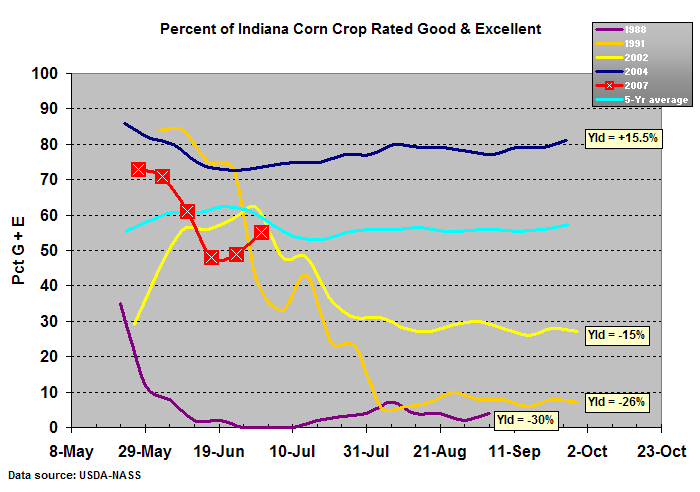
Fig. 2. Percent of Indiana corn crop rated
good & excellent from late May through early July for 2007 versus
several other years and the 5-year average. The yield values shown in
the yellow boxes indicate the percent above or below Indiana corn trend
yield for each indicated year. Source: USDA-NASS, 2007.
Estimates of soil moisture deficits by the Midwest Regional Climate Center (5 July 2007) mirror the estimates of drought conditions. As of 5 July, estimates of soil moisture in the upper 72 inches throughout most of the eastern half of Indiana ranged from 5 to 15% below normal (Fig. 3). Estimates of soil moisture in the upper 12 inches indicate that areas of northeast Indiana were as great as 30% below normal as of 5 July (Fig. 4).
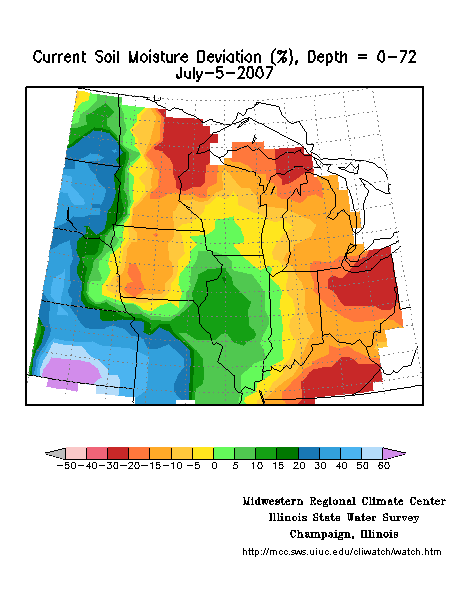
Fig. 3. Estimate of soil moisture deficits
throughout the U.S. Midwest in the upper 72 inches as of 5 July 2007.
Source of image: Midwestern Regional Climate Center, http://mcc.sws.uiuc.edu/cliwatch/watch.htm.
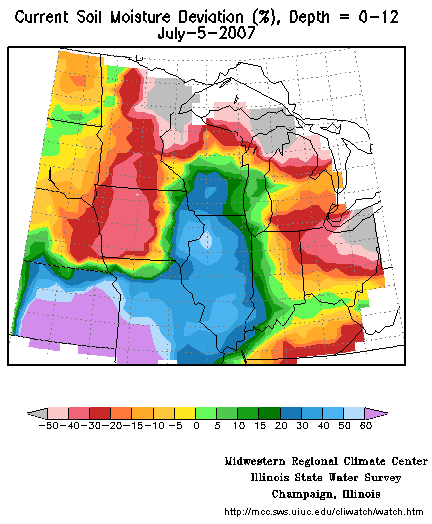
Fig. 4. Estimate of soil moisture
deficits throughout the U.S. Midwest in the upper 12 inches as of 5 July
2007. Source of image: Midwestern Regional Climate Center, http://mcc.sws.uiuc.edu/cliwatch/watch.htm.
Obviously, none of this is any surprise to those growers affected by dry soils this current growing season. The nagging question that continues to be debated at the corner table of the Chat ‘n Chew Café is how much yield potential has been or will be lost due to these dry soils and hot temperatures?
Unfortunately, accurately predicting the effects of severe drought stress on corn grain yield is never easy or straightforward. The actual yield for any given field is determined cumulatively throughout the entire season; not at any specific point in time. Like any stress, the effects of drought on corn grain yield depend on the severity of the stress, the duration of the stress, and the timing of the stress with crop developmental stages.
Grain yield can be broken down into several components, each of which is determined or “set” at different periods throughout the growing season (Fig. 5). The potential number of productive plants per acre is determined during the first 30 to 45 days after planting (germination through about leaf stage V6). Severe stress throughout the growing season can continue to affect harvestable plant population until harvest is complete.

Fig. 5. An illustration of the timing
of yield component determination in corn.
The potential size of the ear (number of ovules) is determined over a
lengthy period ranging from about leaf stage V5 to maybe as late as V15
(Nielsen, 2007b). The success or
failure of pollination determines what percentage of the number of ovules
will be fertilized and thus initiate kernel development (Nielsen,
2007a). The actual number of surviving kernels is largely determined
during the first week or two following pollination (Nielsen,
2007e). 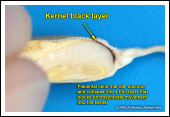 Finally,
dry weight per kernel is determined throughout the remainder of the so-called
“grain fill” period (Nielsen, 2007d)
that terminates with the development of the kernel black layer (aka physiological
maturity).
Finally,
dry weight per kernel is determined throughout the remainder of the so-called
“grain fill” period (Nielsen, 2007d)
that terminates with the development of the kernel black layer (aka physiological
maturity).
Given the early beginning of drought or near-drought conditions this year in Indiana, essentially every single yield component may be influenced in some fields. Stand establishment in 2007 was erratic or non-existent due to excessively dry seedbeds in some areas of the state (Nielsen, 2007h). Consequently, the productive number of plants per acre was significantly reduced from the “git-go”.
Ear size determination was undoubtedly impeded in some fields due to severe drought stress from V5 to V15. Dryness that caused leaf rolling only in the afternoon hours is probably not severe enough to significantly reduce ear size determination. Leaf rolling that occurred from shortly after sun-up to after dusk probably constitutes severe drought stress. Leaf and/or plant death due to drought obviously constitutes severe drought stress.
The success of pollination and the grain fill period this current season largely remains to be seen as of the date that I’m writing this article. Traditionally, the pollination phase is referenced as THE most important yield-determining period of the growing season relative to the percent of yield potential that can be lost per day of severe stress (Thelen, 2007). When coupled with the importance of the first couple of weeks following pollination that determines “kernel set” (Nielsen, 2004b), there is no question that the next few weeks will be very important in determining the severity of yield loss due to drought this year.
Estimating actual or percent yield loss due to drought is challenging for the reasons I’ve outlined above. Obviously, one can estimate yield potential due to a lower productive plant population by using available references on yield and plant population (Nielsen, 2007h). Assessing ear size potential prior to pollination is difficult to do because of the small size of the developing cobs (Nielsen, 2007b). Assessing the success of pollination can be done shortly after pollination is complete by conducting the so-called “ear shake” test (Nielsen, 2007a).
The first opportunity to integrate most of the yield components into a pre-harvest estimate of grain yield occurs by dough stage of kernel development or later when one can count the likely number of harvestable ears per acre and the average number of kernels per ear (Nielsen, 2007c). This so-called “yield component” method for estimating grain yield will place you in the proverbial “ball park” for accuracy, but can vary plus or minus 20 bushels per acre in my experience. This method for estimating grain yield is not precise because kernel dry weight (the final yield component) cannot be estimated prior to physiological maturity and so the formula uses a proverbial “fudge factor” for kernel weight in order to complete the yield estimate.
Bottom line…………This year’s drought conditions will undoubtedly result in lower than desired corn grain yields for some growers; the magnitude of which is nearly impossible to estimate with any degree of accuracy at this point in time.
Related References
Midwest Regional Climate Center. 2007. Midwest Climate Watch. [On-Line]. Available at http://mcc.sws.uiuc.edu/cliwatch/watch.htm. (URL verified 7/5/07).
Nafziger, Emerson. 2007. How Soon and How Much Does It Need to Rain? Illinois Pest & Crop Bulletin. Univ. of Illinois. [On-Line]. Available at http://www.ipm.uiuc.edu/bulletin/article.php?id=782. (URL verified 7/5/07).
Nielsen, R.L. (Bob). 2004b. Yield Loss Potential During Grain Fill. Corny News Network, Purdue Univ. [On-Line]. Available at http://www.kingcorn.org/news/articles.04/GrainFillStress-0705.html. (URL verified 7/4/07).
Nielsen, R.L. (Bob). 2007a. A Fast & Accurate Pregnancy Test for Corn. Corny News Network, Purdue Univ. [On-Line]. Available at http://www.kingcorn.org/news/timeless/EarShake.html. (URL verified 7/2/07).
Nielsen, R.L. (Bob). 2007b. Ear Size Determination in Corn. Corny News Network, Purdue Univ. [On-Line]. Available at http://www.kingcorn.org/news/timeless/EarSize.html. (URL verified 7/5/07).
Nielsen, R.L. (Bob). 2007c. Estimating Corn Grain Yield Prior to Harvest. Corny News Network, Purdue Univ. [On-Line]. Available at http://www.kingcorn.org/news/timeless/YldEstMethod.html. (URL verified 7/13/07).
Nielsen, R.L. (Bob). 2007d. Grain Fill Stages in Corn. Corny News Network, Purdue Univ. [On-Line]. Available at http://www.kingcorn.org/news/timeless/GrainFill.html (URL verified 7/2/07).
Nielsen, R.L. (Bob). 2007e. Kernel Set Scuttlebutt. Corny News Network, Purdue Univ. [On-Line]. Available at http://www.kingcorn.org/news/timeless/KernelSet.html. (URL verified 7/13/07).
Nielsen, R.L. (Bob). 2007fe. Silk Emergence. Corny News Network, Purdue Univ. [On-Line]. Available at http://www.kingcorn.org/news/timeless/Silks.html (URL verified 7/2/07).
Nielsen, R.L. (Bob). 2007g. Tassel Emergence & Pollen Shed. Corny News Network, Purdue Univ. [On-Line]. Available at http://www.kingcorn.org/news/timeless/Tassels.html (URL verified 7/2/07).
Nielsen, R.L. (Bob). 2007h. Variable Emergence Due to Variable Seedbed Moisture. Corny News Network, Purdue Univ. [On-Line]. Available at http://www.kingcorn.org/news/articles.07/VariableEmergence-0520.html. (URL verified 7/5/07).
Thelen, Kurt. 2007. Assessing drought stress effects on corn yield. Field Crop Advisory Team Alert Newsletter. Michigan State Univ. [On-Line]. Available at http://www.ipm.msu.edu/cat07field/fc06-28-07.htm. (URL verified 7/5/07).
Thomison, Peter. 2007. Drought and Heat Stressing Corn. C.O.R.N. Newsletter, Ohio State Univ. [On-Line]. Available at http://agcrops.osu.edu/story.php?setissueID=189&storyID=1134. (URL verified 7/5/07).
USDA-NASS. 2 July 2007. Indiana Crop & Weather Report. USDA-Nat’l Ag Statistics Service. Vol. 57, No. 26. [On-Line]. Available at http://www.nass.usda.gov/Statistics_by_State/Indiana/Publications/Crop_Progress_&_Condition/2007/we2607.pdf. (URL verified 7/2/07).
U.S. Drought Monitor. 2007. [On-Line]. Available at http://www.drought.unl.edu/dm/monitor.html. (URL verified 7/3/07).

